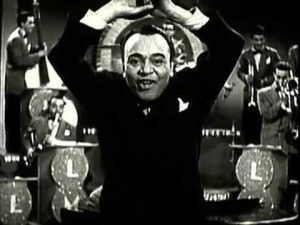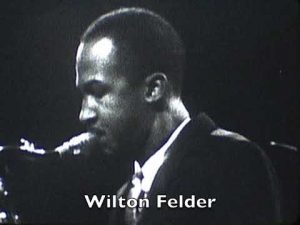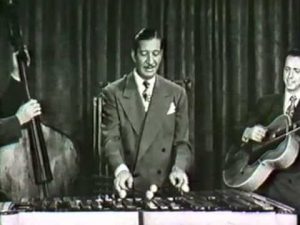Most of us, I presume, would prefer straight ahead musical presentations on screen: show me the band, give me some close ups of the soloists and vocalist, don’t mess with my music. A SOUNDIES reel, on the other hand, required variety. Unfettered band performances were rare indeed. One of the most common variations in presentation is what SOUNDIES producers called the “song story”: present the featured artists, then have them act out a story, as suggested by the lyrics.
The theme of TAKE ME BACK BABY is one of the oldest known to mankind: someone has been cheating on his girlfriend, and he now asks her to “take him back.” In this case, Jimmy Rushing is the guilty party, asking Winnie Johnson (a SOUNDIES regular) to forgive him. The song was recorded by the Basie orchestra in September 1941, and here they perform the arrangement by Andy Gibson, complete with instrumental obbligatos by Tab Smith, alto sax; Dickie Wells, trombone; and Count Basie at the piano.
The script, to the extent that there is one, was provided by Charles Abbott, who created the scenarios for around 100 SOUNDIE shorts. The film opens with a delicious pan of the reed section, let-to-right on screen here: Buddy Tate, Tab Smith, Earl Warren, Jack Washington, Don Byas …. and Jimmy Rushing, miming a tenor saxophone. Jimmy falls asleep, and the action shifts to Winnie Johnson’s house, with Jimmy begging her to “take me back, baby.” The plot unfolds, and then a Basie slap to the head wakens him — Jimmy was only dreaming — and he rejoins the reeds section as the SOUNDIE draws to a close.
Now, a short (but fascinating) digression. Directly following the recording session (sometime during the week of October 27, 1941), Jimmy would have been given a recording, a 78 rpm acetate, to take home, listen to, and use in practicing his sync. I recently turned up a set of 75 of these disks, and label scans of some of them will be uploaded soon. Jimmy lip syncs well, if without much emotion; this would have been the director’s call. Winnie listens patiently, throws him the key. But then we move into the house, and Winnie discovers Jimmy’s little black book (the first name is Lulu White, a well-known New Orleans madame),u and you do not have to be an expert lip reader to see that she says, “Shit!” Since this was a sideline session — just performing to playback — we hear nothing.



